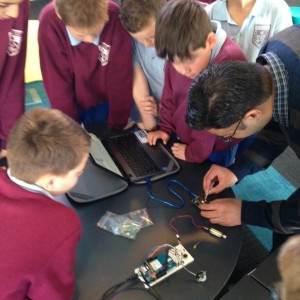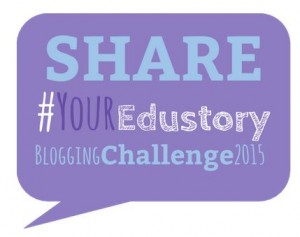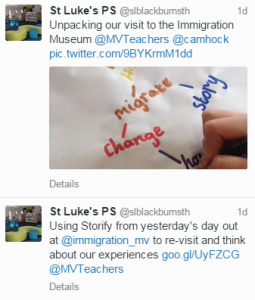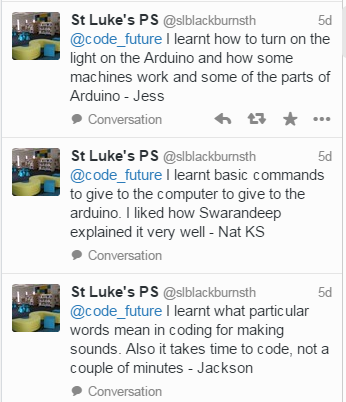Connected-Learning
Twitter+Storify = Learning & Sharing & Curating
Last Monday a group of our students attended an excursion in our city. They visited the Immigration Museum and explored many exhibitions and wandered the city noting historical changes.
The experience was well documented by the Tweeting teachers as well as the Museum Educators (@MvTeachers) . Anyone watching from afar was well informed and connected to what was happening throughout the day.
The Tweets were then curated into a Storify – capturing a timeline of the events and enhanced by the ability to add relevant weblinks.
Back at school, the Storify became a journal of the days events, shared on the class blogs. It was also used to enable a de-brief of the day before the students began unpacking the ideas they explored. It can be edited to show the follow up and further aspects of the learning.
A tool that I once saw from one light only (capturing a series of Tweets), I now see with a broader lens.
I wonder how else it might enhance our learning?
Code the Future – First steps
I was lucky  enough to witness the initial stages of a Project that began as an idea at a StartUp weekend in Melbourne in November last year. Code the Future aims to ‘connect developers with educators to help students learn how to code’.
enough to witness the initial stages of a Project that began as an idea at a StartUp weekend in Melbourne in November last year. Code the Future aims to ‘connect developers with educators to help students learn how to code’.
It sounded like a good idea and personally having little confidence with the technical side of things I could see no down side to signing up. Our school community are very open to connecting with people who can enhance our learning and here was another great opportunity.
My first contact with our mentor was excellent as immediately he had an idea that was raising the bar beyond the possibilities I had explored – suggesting we experiment with Arduino . If nothing else was to be gained, his introduction to our students raised their awareness of an area of technology most take for granted.
My intention with this project within our school is that we will :
- expose students to more facets of digital technologies
- light some passion in certain students
- connect to outside experts (extending the possibilities beyond our skillsets)
- benefit from and demonstrate the power of volunteering
- activate the Digital Technologies curriculum in a small way
- allow the project to evolve organically
- create an ongoing relationship with our mentor and maybe more to model to students the benefit of connecting
- model to the students as teacher learn and problem solve alongside them
- support particular students who thrive on these types of open ended activities
- use a secure online space to share questions and learning
It is early days but seeing the excitement on certain little faces when the Starter kits arrived and were unpacked and checked out was a good indication that we are on to something good.
We established an Edmodo group and sent some kits home over the holidays – already the conversations have begun and I am once again struck by the power of connecting. My role as a teacher is transformed by being the intermediary and I love it !
Some of our student responses so far :
Are you wondering about Arduino now ? Here is a short Introductory tutorial and a cool example of what can be achieved :
Networks : Connecting our learners
 The #YourEduStory challenge for this week is “What is connected learning and WIIFM?” (WIIFM = What’s in it for me?) and I realised that I had an unpublished post from 2013 (among many others) that could partially address this topic.
The #YourEduStory challenge for this week is “What is connected learning and WIIFM?” (WIIFM = What’s in it for me?) and I realised that I had an unpublished post from 2013 (among many others) that could partially address this topic.
In 2013, I wrote:
As our world of information overload expands, the use of our networks is getting more and more valuable. Happily accepting that we cannot answer all questions, but that we can help our learners (whether students or teachers) connect with someone who can, is an important mindset of a modern teacher and learner. I gain solace when I am able to connect people, use my online or face to face Professional Learning network (PLN) and say “I don’t know anything about that, but I just might know someone who does !”
I am grateful for the people in my network and I believe the power of these connections is hugely amplified when we each act as ‘nodes’ or connectors to each others networks. On Twitter I regularly see people requesting information from their PLN as they are trusted sources and people willing to help.
My experience indicates that many of our students have yet to see or be exposed to the value or purpose in networking beyond their school environment. We often read that they are already using the power of networks in their social lives, in online games etc but schools are not mirroring this activity.
School must embrace this and model the value of connecting. Class and student blogs, class Twitter accounts, Edmodo, shared Google documents etc, are some of the wonderful vehicles for this connection. Recently one of our students published her work from a Positive Education program on her blog, another school picked it up and used her content for class discussion. The excitement from the young blogger was palpable – she was contributing to other students learning and they were adding value to hers.
Relevant and timely exposure to the value of connecting as learners will provide our students with essential skills.
That was 2 years ago and it still stands. In a few hours at work last week, I spent time getting the nuts and bolts sorted so that our students have access to their own blogs, their Google Apps for Ed accounts, Edmodo accounts. It was tedious administration but vital to exposing them to this type of learning.
The ‘What’s in it for me?” question is partly a no-brainer as Heather so well describes but also a bit awkward. The essence of being connected implies a mutual benefit – sometimes the balance goes one way more than another, but we are more in to the “What’s in it for us?”
Reading Nancy’s response to this prompt, I connected in numerous ways to her story and in particular to “These connections did not happen accidentally.” Like any relationship, they have to be worked on, cultivated and allow to mature and change.
2014 in review

If you write a blog, you have a great record of your thinking: the things that have inspired you, the ideas you have puzzled over, the events you have attended, even the challenges you have faced. I just browsed through my posts from 2014 and although not as numerous as previous years, they tell a story. I seem to have been a bit of professional learning junkie – attended many Teachmeets as well as a couple of formal conferences.
One of my most visited blog posts was You have a class Blog – Now What? I have had the pleasure of working with many teachers helping them with the setting up class blogs and it started to get frustrating that their impact was not as great as I think they might be. I now think that a teacher needs to understand and actively seek the benefits of being a Connected Educator, before or at the very least whilst setting up a blog. So many teachers have said to me that they don’t see the point, no-one reads it and the effort does not translate into any added value for them or their students. The exceptions are those who are creating a network alongside their blogging activities. Whether they be actively engaging their parent community or reaching beyond the school to other classes, they are making a difference and are feeling encouraged to continue.
The concept of collaboration is understood by teachers but when it involves actively pursuing on-line networks, many are yet to take the plunge or even understand the pathway. This is an area I would like to focus my work on in the future. My connections have enriched my career in so many ways that I cannot imagine life without them. I revel in the opportunity to watch a Twitter feed/ Google+ Community, chat at a conference or Teachmeet etc and pick up news or ideas or to ask a question or contribute an answer. Of course, it remains paramount that any of this revolves around relationships. George Couros wrote recently:
If you are a school that does not focus on building relationships, you are on a faster road to irrelevance than one that doesn’t use technology.
In a world where information is easy to access and I can always find better content online than I can in school, the refocus on relationships is more crucial now than ever. Embrace technology; it will provide people opportunities that we could have dreamed of when we were kids. But just remember that people will always be the most important part of the education system.
In conducting a bit of a mental audit on the ways I have seen technology used in my school, I am comfortable that our focus has been on the relationships. At the end of any shared Google document, Tweet, Blog post or Skype call, was a person or a group of people we were actively engaging with. We had clear purpose in our communication – whether it be collaborating on a task, informing parents, seeking information from experts, providing an audience for our young writers. Technology was the enabler for the building and strengthening of the relationships.
George is right “people will always be the most important part” and I would like to thank a small band of my ‘people’ who nominated me for an award this year – I humbly accept it as I said to the teachers I work with I take pride if I have been in any way influential in all the wonderful things they are doing with our students. I draw energy from my association with members of my PLN both at school and beyond and look forward to sharing many more stories in 2015. Now it is time to go to the beach for a bit of rejuvenation!


